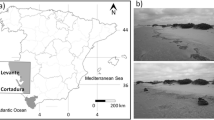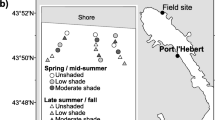Abstract
In the last century, increases in human population and beach tourism have affected coastlines worldwide. Resulting pressures on beach ecological systems demand research concerning tolerance of beach plants to disturbance by humans. At three different Baltic Sea beaches, Atriplex prostrata, Honckenya peploides and Crambe maritima were planted and observed while subjected to trampling stress intensities of 0, 1 and 2 footsteps·m−2·d−1. Plant height, leaf growth, number of leaves, chlorophyll content of leaves and fitness of photosystem II were measured at monthly intervals. Survival of plants was documented until the following summer. Linear mixed effect models fit the effects of trampling intensity, time and species on growth, photosynthetic productivity and reproduction of plants. Survival was fitted using general linear mixed models for binomial data. The results indicated that the annual species A. prostrata showed an initial decrease in growth at the first trampling treatment, but no effects on seed weight due to trampling pressure. Honckenya peploides was not affected by trampling. Crambe maritima showed a reduction in growth and survival under any level of trampling pressure. Experimental trampling pressure was compared to observed trampling intensities at beaches with low visitor frequency, which was ascertained to be between 3 and 8 footsteps·m−2·d−1. Because of the greater potential of endangerment for C. maritima, we suggest that nature conservation focus on reducing human trampling on the upper beach area, e.g. by closing this area. This practice would allow tourists continued recreational access to the water as well as to the lower beach area.





Similar content being viewed by others
Abbreviations
- BSD:
-
Behrensdorf (beach site)
- PSII:
-
photosystem II
- SCH:
-
Schleimuende (beach site)
- STA:
-
Stakendorf (beach site)
References
Acosta A, Carranza M, Izzi CF (2009) Are there habitats that contribute best to plant species diversity in coastal dunes? Biodivers & Conservation 18:1087–1098
Andersen UV (1995) Resistance of danish coastal vegetation types to human trampling. Biodivers & Conservation 71:223–230
Andersone U, Druva-Lūsīte I, Ieviņa B, Karlsons A, Ņečajeva J, Samsone I, Ievinsh G (2011) The use of nondestructive methods to assess a physiological status and conservation perspectives of Eryngium maritimum L.. J Coastal Conservation 15:509–522
Barbier EB, Hacker SD, Kennedy C, Koch EW, Stier AC, Silliman BR (2011) The value of estuarine and coastal ecosystem services. Ecol Monogr 82:169–193
Berg C, Dengler J, Abdank A, Isermann M (2004) Die Pflanzengesellschaften Mecklenburg-Vorpommerns und ihre Gefährdung. Weissdorn-Verlag, Jena
Björkman O (1981) Responses to different quantum flux densities. In Lange OL, Nobel PS, Osmond CB, Zeigler H (eds) Encyclopedia of plant physiology. New Series, Vol. 12A. Springer, Berlin, pp 57–107
Boudreau S, Faure-Lacroix J (2009) Tolerance of sand burial, trampling, and drought of two subarctic coastal plant species (leymus mollis and trisetum spicatum). Arctic 62:418–428
Bretz F, Hothorn T, Westfall P (2011) Multiple comparison using R. Chapman and Hall, London
Brown AC, McLachlan A (1990) Ecology of sandy shores. Elsevier Science Publisher, Amsterdam
Brown AC, McLachlan A (2002) Sandy shore ecosystems and the threats facing them. Some predictions for the year 2025. Environm Conservation 29:77–92
Davenport J, Davenport JL (2006) The impact of tourism and personal leisure transport on coastal environments: A review. Estuarine Coastal Shelf Sci S 67:208–292
Defeo O, McLachlan A (2005) Patterns, processes and regulatory mechanisms in sandy beach macrofauna: a multi- scale analysis. Mar Ecol Progr Ser 295:1–20
Defeo O, McLachlan A, Schoeman DS, Schlacher TA, Dugan J, Jones A, Lastra M, Scapini F (2009) Threats to sandy beach ecosystems: A review. Estuarine Coastal Shelf 81:1–12
Ellenberg H, Leuschner C (2012) Vegetation Mitteleuropas mit den Alpen. 6th edn. Eugen Ulmer, Stuttgart
EU: European Comission (1998) Facts and figures on the Europeans on holidays. Executive summary. Eurobarometer, 48, Brussels
EU: European Parliament, Policy Department B (2008) The impact of tourism on coastal areas: regional development aspects. Brussels
Fritz KM, Evans MA, Feminella JW (2004) Factors affecting biomass allocation in the riverine macrophyte Justicia Americana. Aquatic Bot 78:279–288
Garcia-Mora MR, Gellego-Fernandez JB, Garcia-Novo F (1999) Plant functional types in coastal foredunes in relation to environmental stress and disturbance. J Veg Sci 10:27–34
Gilbert M, Pammenter N, Ripley B (2008) The growth responses of coastal dune species are determined by nutrient limitation and sand burial. Oecologia 156:169–178
Haigh MJ (1977) The use of erosion pins in the study of slope evolution. In Shorter Technical Methods (II). Technical Bulletin No 18, British Geomorphological Research Group Geo Books, Norwich, UK
Haller I, Stybel N, Schumacher S, Mossbauer M. (2011) Will Beaches be enough? Future challenges on coastal tourism at the German Baltic Sea. J Coastal Res 61:70–80
Harper FC, Warlow WJ, Clarke BL (1961) The forces applied to the floor by the foot in walking. 1. Walking on a level surface. Natl Building Stud Res Pap 32
Hesp P, Schmutz P, Martinez MI, Driskell L, Orgera R, Enken K, Revelo NAR, Orocio OAJ (2010) The effect on coastal vegetation of trampling on a parabolic dune. Aeolian Res 2:105–111
Hylgaard T (1980) Recovery of plant communities on coastal sand-dunes disturbed by human trampling. Biol Conservation 19:15–25.
Irmler U (2012) Effects of habitat and human activities on species richness an assemblages of staphylinidae Coleoptera in the Baltic Sea. Psyche 2012:1–12 doi:10.1155/2012/879715
Jedrzejczak MF (2004) The modern tourist's perception of the beach: Is the sandy beach a place of conflict between tourism and biodiversity? Coastline Rep 2:109–119
Jędrzejczak MF (2005) Sandy coastline ecosystem management – Bridging sustainability and productivity of sandy beaches. In Herrier J-L, Mees J, Salman A, Seys J, Van Nieuwenhuyse H, Dobbelaere I (eds) Proceedings 'Dunes and Estuaries 2005': International conference on nature restoration practices in European coastal habitats, VLIZ Special Publication, 19, Koksijde, Belgium, pp 601–603
Labuz T, Grunewald R (2007) Studies on vegetation cover of the youngest dunes of the Swina Gate Barrier (Western Polish coast). J Coastal Res 23:160–172
Laird NM, Ware JH (1982) Random-effects models for longitudinal data. Biometrics 38:963–974
Lee JA, Ignaciuk R (1985) The physiological ecology of strandline plants. Vegetatio 62:319–326
Liddle MJ (1973) The effects of trampling and vehicles on natural vegetation. PhD thesis, University College of North Wales, Bangor
Liddle MJ (1975) A selective review of the ecological effects of human trampling on natural ecosystems. Biol Conservation 7:17–36
Liddle MJ (1991) Recreation ecology: effects of trampling on plants and corals. TREE 6:13–17
Lu C, Lu Q, Zhang J, Kuang T (2001) Characterization of photosynthetic pigment composition, photosystem II photochemistry and thermal energy dissipation during leaf senescence of wheat plants grown in the field. J Exp Bot 52:1805–1810
Martinez ML, Psuty NP (2004) Coastal dunes: ccology and conservation. Springer, Berlin, Heidelberg
McLachlan A, Defeo O, Jaramillo E, Short AD (2013) Sandy beach conservation and recreation: Guidelines for optimizing management strategies for multi-purpose use. Ocean Coastal Managem 71:256–268
Mossbauer M, Haller I, Dahlke S, Schernewski G (2012) Management of stranded eelgrass and macroalgae along the German Baltic coastline. Ocean Coasta. Managem 57:1–9
Murchie EH, Horton P (1997) Acclimation of photosynthesis to irradiance and spectral quality in British plant species: chlorophyll content, photosynthetic capacity and habitat preference. Pl Cell Environm 20:438–448
Pinheiro JC, Bates DM (2009) Mixed-effects models in S and S-Plus. Springer, Berlin, Heidelberg
Porra RJ, Thompson WA, Kriedemann, PE (1989) Determination of accurate extinction coefficients and simultaneous equations for assaying chlorophylls a and b extracted with four different solvents: verification of the concentration of chlorophyll standards by atomic absorption spectroscopy. Biochem Biophys Acta 975:384–394
Puijalon S, Piola F, Bornette G (2008) Abiotic stresses increase plant regeneration ability. Evol Ecol 22:493–506
Quinn NW, Morgan RPC, Smith AJ (1980) Simulation of soil erosion induced by human trampling. J Environm Managem 10:155–165.
R Development Core Team (2012) R: a language and environment for statistical computing. R Foundation for Statistical Computing, Vienna, Austria
Santoro R, Jucker T, Prisco I, Carboni M, Battisti C, Acosta ATR (2012) Effects of trampling limitation on coastal dune plant communities. Environm Managem 49:534–542
Schierding M, Vahder S, Dau L, Irmler U (2011) Impacts on biodiversity at Baltic Sea beaches. Biodivers & Conservation 20:1973–1985
Schlacher TA, Dugan J, Schoeman DS, Lastra M, Jones A, Scapini F, McLachlan A, Defeo O (2007) Sandy beaches at the brink. Diversity & Distrib 13:556–560
Schlichting E, Blume H-P, Stahr K (1995) Bodenkundliches Praktikum – Eine Einführung in pedologisches Arbeiten für Pedologen, insbesondere Land- und Forstwirte und für Geowissenschaftler. 2nd ed. Blackwell Science, Berlin, Wien
Schmidt L (2009) Impact of wounding and biotic stress on primary metabolism and growth processes of different plant species. Dissertation, University of Düsseldorf
Scott GAM (1976) The ecology of shingle beach plants. J Ecol 51:517–527
Scott GAM, Randall RE (1976) Crambe maritima L. J Ecol 64:1077–1091
Seer FK, Irmler U, Schrautzer J (in prep.) Beaches under pressure – Effects of human access on vegetation at Baltic Sea beaches
Sun D, Liddle MJ (1993) Plant morphological characteristics and resistance to simulated trampling. Environm Managem 17:511–521
Verbeke G, Molenberghs G (2000) Linear mixed models for longitudinal data. Springer, Berlin Heidelberg
Woodell SRJ (1985) Salinity and seed germination patterns in coastal plants. Vegetatio 61:223–229
Acknowledgements
Thanks are due to W. Bilger of the Department of Plant Physiology of the Botanical Institute of the University of Kiel for his close cooperation and the Botanical Garden of the University of Kiel for growing and nursing the beach plants. We would like to thank M. Hasler for his helpful advice on the statistical analysis and two anonymous reviewers for their fundamental critiques of the manuscript. We also thank the Deutsche Bundesstiftung Umwelt (DBU) and the Lighthouse Foundation for funding our project.
Author information
Authors and Affiliations
Corresponding author
Rights and permissions
About this article
Cite this article
Seer, F.K., Irmler, U. & Schrautzer, J. Effects of trampling on beach plants at the Baltic Sea. Folia Geobot 50, 303–315 (2015). https://doi.org/10.1007/s12224-015-9230-z
Received:
Accepted:
Published:
Issue Date:
DOI: https://doi.org/10.1007/s12224-015-9230-z




